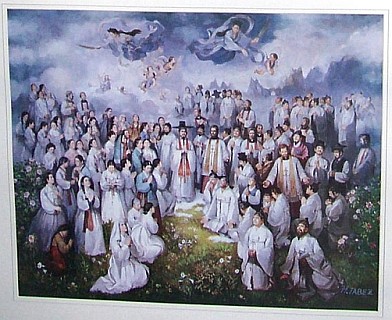
South Korea
Catholic places
The Korean Church is born of itself at the request of Koreans who read Christian texts from China in the 18th century. Within 230 years Christianity grew from 0% to over 30% (some sources indicate 40% but it seems a bit overestimated) including 10% of Catholics in a country deeply rooted in Confucianism and although it has not been spared by several persecutions. This history of faith and growth is exceptional in Asia. Below, some Catholic places of South Korea from left to right and from top to bottom : Seoul (Jeodulsan, Saenamteo, Myong dong), Chon Jin Am, Namyang, Mirinae, Baeron, Galmaemot, Nabawi, Yongsu.
Seoul
In Seoul, there is of course the cathedral but also two Catholic shrines : Jeoldusan and Saenamteo.
Cathedral of Seoul
It was built by a father of the Paris Foreign Missions (MEP) in 1898 and is "dedicated" to Our Lady of Lourdes, who has great significance for Catholics in South Korea.

The crypt contains the remains of nine martyrs (the first 5 below are canonized) :
- 7 were executed in Saenamteo in 1839 with 3 fathers MEP canonized in 1984 : Bishop Imbert, father Maubant and father Chastan (see Saenamteo) as well as 4 Koreans (among whom 2 are unknown).
- 2 MEP fathers were executed in 1866 (Jean Antoine Pourthié and Michel Petitnicolas).
Jeoldusan, the "hill of decapitation"
After the intervention of French naval forces in 1866 in response to the massacre of 9 French missionaries (among whom 7 will be canonized) out of the 12 present in Korea, the Korean ruler sets up a great persecution of Christians dixit : "who embraced the new religion of the Western demons".

29 victims (5 were without name) were officially reported as having been decapitated in this place before their heads and bodies were thrown in the sea to prevent Christians to recover them. There were a lot more (but without last name)... The crypt of the basilica contains the relics of martyrs, several of them were canonized by Pope John Paul II in 1984.
Note : they are the martyrs of the persecution of 1866 (not necessarily in Jeodulsan)...
See internet links : www.jeoldusan.or.kr and www.visitkorea.or.kr
Saenamteo
It was a former military camp that served as a place for execution of opponents of the Joseon Dynasty. It is also the place of martyrdom of many Christians among whom MEP
fathers (Foreign Mission of Paris) but also the first father sent to Korea by the Chinese at the request of the Korean faithfuls (a Chinese father Chu Mo Moon) in 1801,
the first Korean father St Andrew Kim Taegon in 1846 (canonized by Pope John Paul II in 1984 with 102 other martyrs).
Many MEP fathers were executed including 2 bishops and 5 fathers (3 in 1839 and 4 in 1866) who were canonized in 1984. The MEP martyrs of 1839 were : Bishop Imbert
(2nd Bishop of Korea), father Maubant and father Chastan MEP who were first MEP missionaries in Korea (as later for Bishop Daveluy -See Galmaemot- they surrendered
to avoid a massacre).
The basilica was built in Korean style, which is uncommon.
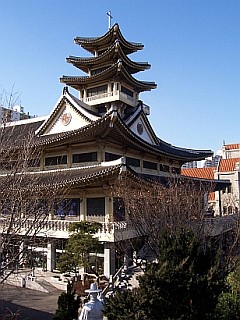
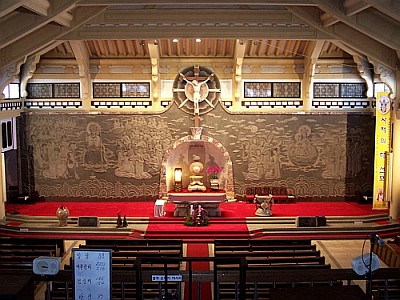
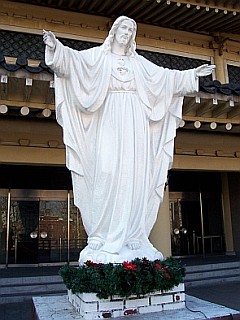
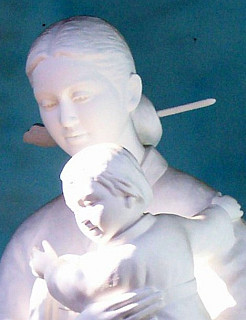
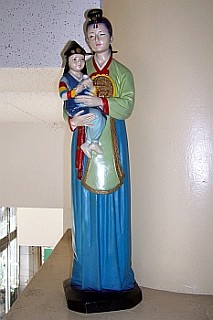


Holy Relics of 9 Saints are present in the crypt. 8 of this Saints were executed in Saenamteo : 3 French missionaries tortured in 1839, 4 French missionaries tortured in 1866 and Korean father Andrew Kim Taegon. The 9th Saint is a layman Korean martyred in 1866 at the South Gate of Seoul.
Note 1 : relics of Bishop Imbert, father Chastan and father Maubant are also present in the crypt of the Cathedral Myong Dong.
Note 2 : The MEP were designated by the Pope to fulfil the requests of Korean faithfuls to have priests (in 1811 and 1825). Bishop Barthélémy Bruguière (then in Siam) was then appointed the first bishop of Korea but died on the road before reaching Korea. The first missionaries to arrive in Korea are father Maubant, father Chastan and Bishop Imbert.
Chon Jin Am
It is the birthplace of the Catholic Church in Korea in 1779. Five Koreans withdrew in Chon Jin Am hills for a spiritual quest. They discovered the writings of Christianity by Jesuit Mateo Ricci from China and adhered to the Catholic faith. One of them went to China to meet Catholic Fathers and be baptized. The graves of these first five Catholics are on the site.

Note : Catholic faith already surreptitiously appeared in Korea during the Japanese invasion of 1592 (several Korean prisoners
in contact with Japanese Christians converted in their turn), but disappeared with the defeat of Japan (the prisoners were not released and they also had to go
in Japan).
During the Japanese presence, a Jesuit missionary was even present on the Korean soil to give the Eucharist to Catholic Japanese soldiers. But he was not
in contact with the natives and had to leave with the Japanese troops.
Thus we can say that the Korean Church is born of itself, without the intervention of missionaries. The latter have also been approached by the Korean priests themselves
who needed to live their faith.
A major project supposed to last 100 years forsees the construction of a huge basilica...

Namyang
It is a place dedicated to the Virgin Mary and the Sacred Heart of Merciful Jesus (who appeared to a Polish sister, Saint Faustina in the '70s). Remarkably, there is a giant rosary and a giant rosary of Divine Mercy. We feel well in this place favourable to meditation (even in winter).


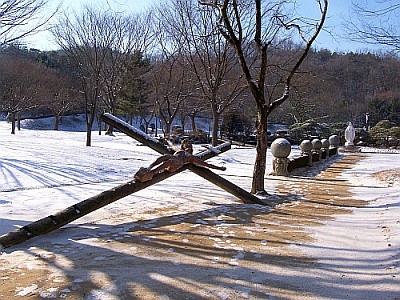
Mirinae
This is the place where are the tomb of the first Korean priest St. Andrew Kim Taegon and the bishop who ordained him : Bishop Ferreol.
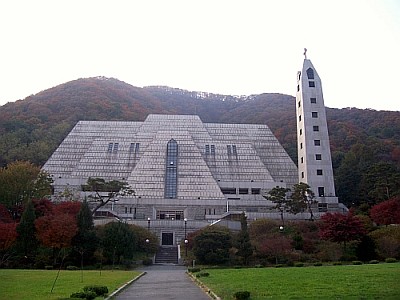
Baeron
This is the place of the first seminar in Korea (underground).

Galmaemot
This is the place of martyrdom of many Christians among whom a bishop and two MEP fathers during the persecutions of 1866 : Bishop Daveluy, father Luc Huin, and father Pierre Aumaître who surrendered to avoid a massacre, but, sadly, the massacre was not avoided. Two Korean collaborators surrendered with them and were also martyred. They were all canonized in 1984 by Pope John Paul II when canonizing 103 martyrs of Korea.


Nabawi
This is the place where the first Korean priest St. Andrew Kim Taegon landed on his return to Korea, along with Bishop Ferréol and Bishop Daveluy.

Yongsu (in Jeju island)
The first Korean priest St. Andrew Kim Taegon was formed in China. On his way back to Korea, he first stopped at the island of Jeju, in Yongsu, before resuming his sea journey to finally land in Nabawi. There is a memorial in Yongsu with a reconstruction of his "skiff" called the Raphael.
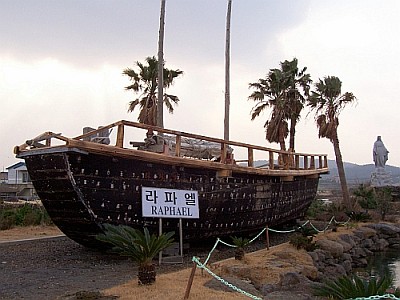
Below, a reliquary and a painting of Korean martyrs canonized in 1984 by Pope John Paul II. We can see St. Andrew Kim Taegon in the center.

